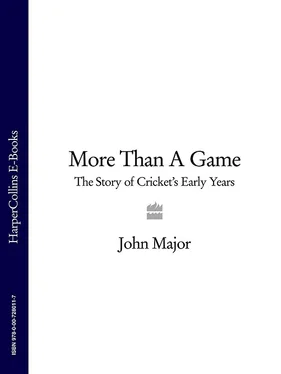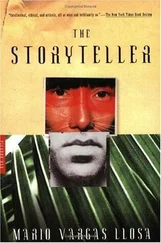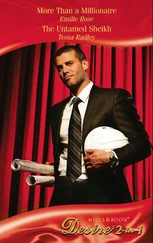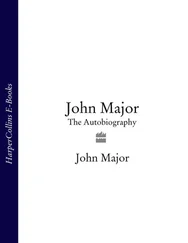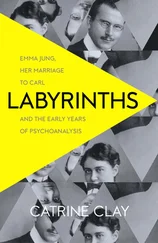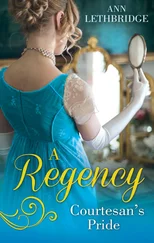The Story of Cricket’s Early Years

JOHN MAJOR

To Norma, Elizabeth, James and Luke
LIST OF ILLUSTRATIONS
PREFACE
1 The Lost Century of Cricket
2 The Early Patrons
3 The Later Patrons
4 The Men Who Made Cricket
5 Cricket Spreads: Early Roots
6 The Round-Arm Rebellion
7 The Mandarins of Lord’s
8 The Rise and Fall of Single-Wicket
9 The Missionary and the Mercenaries
10 Wider Still and Wider: Cricket Goes Abroad
11 The Birth of the Ashes
12 The Boom in Leisure: Competition for Cricket
13 The Cricketers and the Counties
14 The Chroniclers and the Scribes
15 The Autocrats
16 The Grand Old Man and the Backroom Boy
17 Your English Summer’s Done
AFTERWORD
APPENDIX 1: ‘Articles of Agreement by & between His Grace the Duke of Richmond and Mr. Brodrick (for two Cricket Matches) concluded the Eleventh of July 1727’
APPENDIX 2: Rules of the White Conduit Club
APPENDIX 3: ‘Laws for Single Wicket’ (1831)
APPENDIX 4: Important Single-Wicket Matches 1800–1848
APPENDIX 5: W.J. Prowse, ‘In Memoriam, Alfred Mynn 1807–1861’
ACKNOWLEDGEMENTS
INDEX
COPYRIGHT
ABOUT THE PUBLISHER
Charles Lennox, second Duke of Richmond, a keen gambler with a lifelong love of cricket. Mezzotint by John Faber Jr, after John Vanderbank. (Courtesy National Portrait Gallery, London)
Sir William Gage, whose estate Firle in East Sussex was one of the cradles of eighteenth-century cricket. (Courtesy of the Firle Estate Trustees)
Cricket being played in 1743 at the Artillery Ground in Finsbury, London. (The Roger Mann Collection)
Lionel Sackville, first Duke of Dorset, one of the great early patrons of the game. Portrait by Sir Godfrey Kneller, 1717. (Private Collection, © NTPL/John Hammond)
Charles Sackville, second Duke of Dorset. Portrait by Rosalba Carriera. (Private Collection, © NTPL/John Hammond)
Frederick Louis, Prince of Wales, an enthusiastic early patron of cricket. Portrait miniature by Gaetano Manini, 1755. (© Ashmolean Museum, University of Oxford/The Bridgeman Art Library)
The Duke of Cumberland, a better judge of a soldier than a cricketer. Portrait by David Morier. (© Private Collection/Philip Mould Ltd/The Bridgeman Art Library)
A match at Moulsey Hurst, on the banks of the river Mole in Surrey. (The Roger Mann Collection)
‘Lumpy’ Stevens, the most deadly underarm bowler of his day. (The Roger Mann Collection)
Sir Horace Mann, the most amiable of cricket’s early benefactors. (The Roger Mann Collection)
John Frederick Sackville, third Duke of Dorset, the third in a line of great cricketing patrons. Portrait by Sir Joshua Reynolds, 1769. (Private Collection, © NTPL/John Hammond)
The Countess of Derby plays cricket with other ladies at The Oaks, in Surrey, in 1779. (The Roger Mann Collection)
John Nyren, whose memories of Hambledon have given us a vivid picture of early cricket. (The Roger Mann Collection)
An eighteenth-century cricket match, possibly at Hambledon. (The Roger Mann Collection)
A page from a sketchbook by George Shepheard, showing some of the Hambledon cricketers. (The Roger Mann Collection)
The Bat and Ball Inn on Broadhalfpenny Down, Hambledon. (The Roger Mann Collection)
‘Silver Billy’ Beldam joined the Hambledon club in 1785, and lifted the art of batting to a new level of style and elegance. (The Roger Mann Collection)
Lord Winchilsea, a key founder of the MCC who encouraged Thomas Lord to acquire its first ground. (The Roger Mann Collection)
Cricket Played by the Gentlemen’s Club, White Conduit House, Islington in 1784. (The Roger Mann Collection)
An engraving, after Thomas Rowlandson, depicting a match between the ladies of Hampshire and Surrey at Newington in 1811. (The Roger Mann Collection)
The canny Yorkshireman Thomas Lord, who left the world’s most famous cricket ground as his memorial. (The Roger Mann Collection)
William Ward, a central figure in securing Lord’s place as the headquarters of cricket. (The Roger Mann Collection)
Benjamin Aislabie, first Secretary of the MCC. (The Roger Mann Collection)
Lord Frederick Beauclerk: avaricious, ill-tempered, hypocritical, and adept at bending the rules. (The Roger Mann Collection)
Fuller Pilch, the finest batsman of his day, and ‘single-wicket champion of England’. (The Roger Mann Collection)
John Wisden, the founder of the Almanack and a fast round-arm bowler. (The Roger Mann Collection)
The Scorer , by Thomas Henwood (1842). (The Roger Mann Collection)
Alfred Mynn and Nicholas Felix before their famous single-wicket contest in 1846 for the title ‘champion of England’. (The Roger Mann Collection)
William Clarke, the finest underarm bowler of them all, and the founder of Trent Bridge cricket ground. (The Roger Mann Collection)
Clarke’s All-England Eleven of 1847. (The Roger Mann Collection) The All-England Eleven on the move in 1851, by Nicholas Felix. (The Roger Mann Collection)
George Parr, who succeeded Clarke as leader of Nottinghamshire and the All-England Eleven. (The Roger Mann Collection)
The first English overseas touring team. George Parr’s men gather on deck before their 1859 voyage to North America. (The Roger Mann Collection)
H.H. Stephenson’s English team arrives in Melbourne on Christmas Eve 1861. (The Roger Mann Collection)
Tom Hayward and Robert Carpenter, two fine Cambridgeshire batsmen of the 1860s. (The Roger Mann Collection)
Arthur Haygarth, whose Cricket Scores and Biographies is the bedrock of our knowledge of the years 1744 to 1878. (The Roger Mann Collection)
The 1880 Australians, the first visitors to play a Test match in England. (The Roger Mann Collection)
Charles Alcock, whose immense backstage contribution to cricket warrants a higher place in the mythology of the game than history has yet given him. (The Roger Mann Collection)
Alfred Shaw, who bowled the first over in Test cricket. (The Roger Mann Collection)
Edward Mills Grace, W.G.’s elder brother and one of the most formidable cricketers of his day. (The Roger Mann Collection)
W.G. Grace poses with Harry Jupp of Surrey. (The Roger Mann Collection)
Three of the remarkable Studd brothers, two of whom played Test cricket for England. (The Roger Mann Collection)
‘The Demon’ – Frederick Spofforth, the first of the great Australian bowlers. (The Roger Mann Collection)
The Hon. Ivo Bligh led the English team which recovered the Ashes in Australia in 1882–83. (The Roger Mann Collection)
Lord Harris batting at Lord’s for the Lords and Commons Eleven against the touring Canadians in 1922. (The Roger Mann Collection)
Читать дальше
